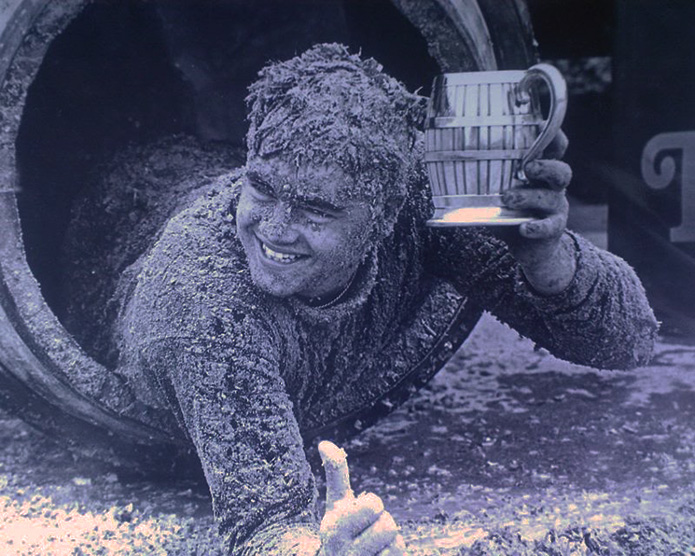
How many people with ‘Cooper’ as a surname do you know? I surmise that most of us will know, or have known, of someone, near or far, literal or lateral, civilian or celebrity, with this traditional surname. In Britain the name ‘Cooper’ originates from the 14th Century when coopers began proudly interchanging their tradename with their surname, as respected members of the craftworking community, making wooden barrels. The history of coopering, from its earliest origins in ancient Egypt (approximately 2700 BC) through to the present day is a fascinating one, and the iconic image of a wooden barrel, brimming with stored bounty, is a romantic one, one which holds a story as intoxicating as the contents often are.
Wooden barrel-making is an age-old craft, associated with apple, butter, rum, wine, whisky, and most notably beer storage, with breweries traditionally employing coopers to make and maintain wooden beer barrels. Techniques are little changed through the millennia – wooden staves, heat softened for pliability, trussed with metal hoops, dressed out and then topped with a heading knife – mysterious in vocabulary with bellies and bungs, cants and chimbs. However, as a trade it has been in steady decline, especially since the latter part of the 20th century when wooden beer barrels were universally replaced by metal casks, as real ale and draught beers were usurped by mass produced keg bitters and lagers. Now, only four breweries employ a cooper in the whole of Britain.
Subsequently, a real ‘cooper’ is now hard to find. Pete Coates is one such rarity, one of only a handful of qualified brewery coopers left in Britain, but with a determination to keep the craft alive for future generations.
About Pete Coates
Pete works as a freelance cooper in St Asaph, North Wales, making casks for micro breweries and charming barrel-inspired decorative furniture through his company Oak Barrel Creations, and provides us with a rare insight into this traditional craft, a craft he honed as an apprentice, in the early 1990s, at the Yorkshire brewery, Theakstons, and continues to loyally practice today. We hope you enjoy reading the article, possibly accompanied by a pint of real ale…
Firstly, for readers that aren’t aware of the craft of coopering, please can you describe what a cooper does?
Basically, it is an ancient craft, dating back to nearly 3 millennia BC in ancient Egypt. The word is thought to come from the Latin word cupa meaning vat; a Roman barrel maker would be called a cuparius, and it’s thought the bending of wood into staves, giving the vessel its distinctive roundedness, was borrowed from ancient boat-building techniques.
A cooper makes and repairs wooden staves which are bound together with hoops, to form vessels with flat ends (or heads) such as barrels, buckets, butter churns, butts, casks, firkins, hogshead, tubs and tuns; they are all known as cooperage. Country coopers were mostly supplying the farming community with buckets, butter-churns, butter-tubs, noggins [small vessels], piggins [small wooden buckets] and tubs, for water, milk and washing. Often coopers travelled around in search of work, adapting their wood and design depending on where they were. Much recycling of wood took place; especially popular were whisky barrels as they gave a pleasant flavour to what was stored within them, such as butter.
Are all coopers the same?
The craft can be divided into four types; a ‘dry’ (or ‘slack’) cooper makes containers for storage and transportation of dry goods, such as fruit and veg, cereals, tobacco or nails; a ‘dry-tight’ cooper makes containers that keep dry goods dry, by keeping moisture out, such as flour or gunpowder when stored and/or transported; a ‘wet-tight’ cooper makes containers for storage and transportation of liquids, that can even be under pressure, such as beer; and a ‘white’ cooper makes straight staved containers for produce that will not be shipped anywhere – such as buckets for water, churns for butter etc.
These days ‘wet-tight’ coopering is the most commonly practised form of coopering; and modern coopering is synonymous with casks, such as whisky and beer casks. ‘Wet-tight’ coopering has been an extremely busy industry over the past 2000 years, since brewing in the Roman times, and especially in English monasteries. Early on beer was brewed to be consumed locally in the village and its catchments, but as demand grew, vessels needed to be developed that could transport the precious liquid further afield, and so barrels evolved.
Why were barrels, and the work of a cooper, so important in the past?
Barrels are extremely practical in terms of both storage and transportation. Barrels and other forms of casks such as firkins and butts, are made from staves, which are long pieces of oak, held together tightly with steel hoops, so tightly that they are watertight, and incredibly strong, which they need to be when they are dropped down through Beer Drop Doors into the beer cellar below.
The staves bow to give the barrel a convex shape, in other words – a belly. This is an extremely useful shape, as a full barrel is extremely heavy when filled, but the shape lends itself to rolling to move and easy to change direction, (with stress distributed evenly to reduce wear and tear). The barrel can be rocked sufficiently until it’s able to push it upright onto the flat ends, then swung over onto the stillage [a type of frame to hold barrels] where the barrel is held in place safely and ready for use. This belly is also useful as the natural yeast sediment within the beer settles there, leaving the beer above it clear and bright.
Coopering is a highly skilled craft; a mix of metalwork and woodwork. It takes many years to become a qualified cooper as the vessels, especially those holding liquids, need to be perfectly constructed to be completely watertight and able to last. Apprenticeships to learn the craft takes time, four years, before you are ready to work independently. Once you’ve completed the apprenticeship, the iconic trussing ceremony takes place, and you become known as a Journeyman Cooper, which basically means I’m free to work anywhere. You only become a Master Cooper once you have trained your own apprentice.
Sorry, I am a bit confused over some of the terminology you talk about related to coopering; can you explain what is barrel, what is a cask, and how these differ from a firkin and so on…?
The cask is the general term for the wooden staved vessels; they are differentiated by volume, a little like the 9 times table; pin – 4.5 gallons; firkin – 9 gallons; kilderkin – 18 gallons; barrel – 36 gallons; hogshead – 54 gallons; puncheon – 72 gallons and butt – 108 gallons. Barrel is the standard brewing unit, which was around 32 gallons in mediaeval times, since standardised to 36. All casks these days are colloquially termed barrels regardless of capacity.
And you also mentioned trussing – what is that?
When you become a qualified cooper you ‘come out’, and you are rolled around the cooperage in a hogshead; all sorts are poured in with you, usually stale beer and woodshavings, sometimes soot, whatever is to hand. This initiation marks the beginning of your career as a journeyman cooper. You feel like you have been trussed like a chicken afterwards!!
Do barrels differ as to whether they are made to hold beer, wine, sherry or whisky?
It is the chosen wood that differs as the compounds in the wood, like tannins and vanillin, enhances the flavour of the liquid within. The compounds present within the wood are dependent on things like the source of the wood, how the staves were cut and dried and the degree of ‘firing’ during manufacture.
Three years is the length of time most barrels become neutral, in other words when all the flavour-adding compounds have been leached out. So, a winery will replace some of its barrels every year, from a very small amount to all of them! Some wineries use 200% new oak – this means that wine is put into new barrels twice during the aging process. Wine making tend to use French common oak, white oak or American white oak; the French oak barrels tend to be either smaller 225 litre ‘Bourdeaux’ barrels or the larger 300 litre ‘Cognac’ barrels.
There are laws stipulating that whisky has to be aged in wooden barrels. For example American ‘straight’ whiskey must be aged for at least two years in new, charred white oak casks. Bourbon whisky aging from 4-9 years in white oak barrels gives the beverage its distinctive coppery hue. Canadian whisky laws stipulate a minimum of three years in wooden casks no larger than 700 litres.
To be marketed as ‘Scotch whisky’, it needs to be stored for a minimum of three years and a day in oak casks, and most are stored for much longer, so the casks need to be wind and watertight, yet still letting the whisky ‘breathe’. Oak enhances the flavours and European oak has quite a pungent smell, so is used for well-aged whiskies; the milder American oak, soaked with bourbon, gives the drink a softer, sweeter flavour. When whisky casks undergo maintenance they are often ‘fired’, which means they are charred on the inside, which is then shaved back to fresh wood and then fired briefly again to coat the inside with a thin layer of carbon. This extends the life of the cask and gives flavour to the whisky; the differences in extent of firing, such light, medium or heavy toasting, will affect the flavour and colour. Casks are most often re-used, and casks previously used for bourbon, port or sherry adds different flavours to a whisky.
At the cooperage at Seguin Moreau, part of the House of Rémy, barrels are made from Limousin oak, because of the vanilla flavour it imparts to the world famous cognac: Rémy Martin.
Sherry is aged in 600 litre casks made from American oak, as it is more porous than French or Spanish oak. Manufacture entails filling the casks five-sixths full, leaving space for ‘two fists’ spare at the top to allow ‘flor’ (a film of yeast) to develop on the liquid; this grows across the surface of the sherry on the walls of the barrels, which gives a distinct flavour!
Asian beverages, including Japanese Sake use Japanese cedar, which gives the finished drink a ‘piney’ and minty flavour. Other woods sometimes used are chestnuts and redwoods.
However, with regards to beer barrels, it’s a popular misconception that the wood from the cask adds flavour to the beer. The beer is generally only in the barrel for a week or so, and so there really isn’t enough time for the beer to derive any flavour from the wood.
Why was wood the material of choice, notably oak, for making barrels, casks etc?
Because of its workability and strength. Oak allows the liquid inside to ‘breath’, allowing an exchange between the liquid inside and the air outside, although this means that a little of the liquid is inevitably lost through evaporation – known commonly as the ‘angels’ share’ (which can form a fungus on surfaces nearby!) – as the contents are able to mature. Sometimes very strong wines are kept in an environment of 100% relative humidity meaning that very little water is able to evaporate, so most of the loss is alcohol; often beverages are topped up from other barrels to prevent significant oxidation. The tight grain of oak allows the gradual extraction of wood flavours and is high in tannin, especially important for red wines to age by removing the oxygen, which would otherwise spoil the wine.
Can you talk us through the steps of making a cask, and outline some of the strangely named specialist tools you use along the way?
You can split the making of a cask into four parts, and all of this is done by eye using tools, most of which are often Victorian in age. Modern tools, which can still mean those dating from the mid 20th century, are not held in such high esteem as traditional pieces, unless they are from one of the renowned specialist toolmakers still in existence.
We start with the ‘dressing’ of the oak staves, which is done using quartered oak, traditionally English, but more often French nowadays. This means that they are shaved and shaped, firstly with a cooper’s (or carpenter’s) axe, using the offset blade, tapering the sides of the stave at both ends. Then, by holding each stave on the cooper’s block with a hook, or clamped on a shave-horse that you can sit upon, the inside of the stave is shaped with a hollowing knife, which unsurprisingly hollows; then the outside corners are shaped with a backing knife.
The staves are then jointed upon a jointer – which is a huge (six foot long) plane – which puts an angle on each stave edge – this bevelled edge needs to be accurate to 1/2000th of an inch, otherwise the cask will not be totally tight – we do this all by eye!
Then the finished staves are assembled within the stave hoops; this is known as ‘raising’ and is extremely physical as the hoops have to be hammered over the staves. The staves are stood on end inside the iron raising hoop, then an ash truss is driven over the top. The cask so far is then moistened, to soften the wood, then held over a gentle fire of wood-shavings to steam it. The smaller truss rings are hammered down over the staves to draw them in together tightly. Today, some of the process is machined; a hydraulic hoop-driver or windlass aligns the hoops around the staves. Traditionally, however, this would be done manually with chains – a very physical task. The cask is placed over the fire again then, to set the staves firmly, so only the top and bottom truss rings need be left on. The stave ends are trimmed with an adze, and then bevelled with a special plane called a topping plane.
The next part is ‘heading’, where the heads at the ends of the cask are shaped. The steel hoops are made on the bick iron (the tapered end of an anvil).
The ‘chiv’ and ‘croze’ form the bevelled groove into which the cask head, also made of oak, will slot; this is known as the chime. The head is measured up by means of a compass (– this can’t be done by eye!); a bandsaw cuts the head to size, then it is shaped to perfection by a special heading knife.
The final part is called the ‘gathering’, where all parts are fixed together with absolute precision. A driver is used to hammer the hoops home. The ‘head’ hoop or ‘chime’ hoop is the hoop nearest the top and bottom of the barrel, the ‘bilge’ hoops are those nearest the bilge/bulge – the belly in the centre and the quarter hoop is placed between the bilge and chime hoops. Hoops are made these days from galvanised iron; they used to be wrought iron and I understand even wooden withies were used! Then a downright and buzz tidies the exterior, a bung hole is created using an auger (bungs were made from wood originally, now they tend to be silicon) and then finally an individual stamp is used to mark the finished cask. An experienced cooper can finish a cask in just under four hours; a piece of precision-crafted ironwork and woodwork!
Coopering was very popular up until the past few decades, but why has the craft fallen out of favour and how many coopers are there left in Britain today?
Butter churns, wooden pails etc have been on the decline since the 19th Century as Britain became increasingly urban and industrial, and the traditional rural products made by a journeyman cooper have sadly been relegated to museums and mock-ups nowadays. Also the traditional brewery, and especially beer barrel coopering, has declined in recent years as technological developments, such as the invention of stainless steel and later aluminium kegs, replaced most wooden containers as storage, transportation and dispensing vessels. Stainless steel and the later aluminium alloy kegs mimicked the shape and size of traditional brewery barrels, so whilst they operated in much the same way, they were significantly lighter but also the same strength. Changes in tastes in beer has also reduced the demand for wooden casks, with a trend in people moving away from real ale and draught beers to keg bitters and lagers, which don’t require wooden casks.
If you go back to the 1960s and 70s, there were literally thousands of coopers still employed in Britain, with a sizeable proportion in the Burton area alone which was a famous brewing town. However, by the time I entered the craft in the early 1990s, there were only about 9 or 10 brewery coopers left remaining. So over the space of twenty or thirty years, the craft has declined massively. For the larger breweries, when aluminium kegs were first introduced, they swapped over quite quickly, but the smaller breweries held onto their wooden barrels for as long as possible rather than incurring the expense of introducing an entire circulation of new aluminium barrels. Once the breweries that were still holding onto their wooden casks realised that it wasn’t financially viable any longer to employ coopers to maintain their aging stock of casks, they made the switch to aluminium kegs.
Today, I believe there are only four British breweries that employ a cooper; Marston’s of Burton-on-Trent, Samuel Smith of Tadcaster, Theakston’s of Masham and Wadworth’s of Devizes, and in total, across the UK, there are only four or five qualified brewery coopers still deriving an income from the craft, of which I’m one of them. It’s the larger real ale breweries that still like to supply their local inns and pubs with cask ale that still employ brewery coopers, and it’s still important for their promotional activity to still be associated with the craft.
For the brewery cooper though, it’s definitely not a lucrative career. Other less skilled tasks within a brewery, such as a forklift driver for example, can earn double the salary of the cooper! It is often for the love of the craft, the reverence towards the tools and the affinity with wood and wood-working that keeps coopers coopering in modern times. It’s what got me started in coopering when I started out my career.
There are a significantly higher number of coopers working in Scottish whisky distilleries, about two hundred of them, as aging whisky in barrels is still an extremely important stage in the manufacturing of spirits; a proven method perfected over centuries, and I imagine it will continue indefinitely.
You had a spell away from coopering, why was that, and why did you return?
I grew up in rural village in the Yorkshire Dales, and trained as a cooper with a local brewery and stayed there for ten years before moving to Wales, partly prompted because my girlfriend wanted a change of scene, but also because I was offered a job working for Toyota paying quite a lot more money than I earned as a brewery cooper. I found that aspect of coopering a bit frustrating, as I felt that for the level of skill that I had attained, that the pay wasn’t very good compared to my friends who had started in other trades. After a number of years at Toyota working shifts, I was offered voluntary redundancy, and with the money I received, I decided to fund my current business, re-entering the craft of coopering. I was very excited by the prospect of using the skills that I had learnt all those years ago again, but most importantly in a situation where I was my own boss, and I relished that freedom of being self-employed. When you work for a large company, you really are just a number, whereas I enjoy the flexibility and autonomy of running my own business, and making my own decisions.
You’ve branched out into making barrel-inspired furniture; why the change in direction?
I’ve had to move with the times and focus on the decorative side of coopering, as there just isn’t the demand from breweries for coopers any longer. I consider myself as someone who is very creative, and I like thinking of ideas of ways in which I can turn a barrel into a variety of functional and decorative purposes.
Where do you source your wood to make your designs?
I create items from used Bordeaux and Burgundy casks and re-using the pre-bent staves and creating new items from them, such as dog baskets, planters, wine cabinets, stools and tables etc. I could make the items from new oak, but the cost of the wood is very expensive, and it’s actually cheaper to buy second-hand casks from France, although if a client stipulates new oak, then I will start from scratch. The benefit of using Bordeaux and Burgundy casks is that they are only used once, and so the casks are in very good quality, which means that the heads are nice and flat, the timbers are nice and round, there’s won’t be any broken staves, and they will only have been lightly toasted. American oak, on the other hand, is exceptionally hard, and therefore more difficult to work with, and it’s likely to have been toasted more heavily, and therefore more charcoal inside. The shape of the wood is also straighter, which isn’t so aesthetically pleasing. So with the pre-used staves, I’ll clean up the wood (adzing and sanding) and reassemble into a new design, as appropriate, and then varnish and/or paint to finish.
Who are your customers and can you talk through some of the examples of products you make?
I don’t really have any one type of customer, and they vary between corporate and private customers. I recently won a contract for an international Australia wine producer to refurbish twenty barrels to be styled in their corporate colours and incorporating their company logo to be positioned in a prominent position at an airport in Dubai.
Whereas for private customers, I generally convert used barrels to create designs such as water butts and planters as outdoor features, bar stools for home bars and breakfast bars, wine cabinets and stands, stools and tables, and a lot more besides.
This summer, I spent quite a lot of time refurbishing an old French wine press for a man who owned a French vineyard; the owner wasn’t really sure which trade to call in for help, but he carried out some research and found my website; making the association that the cylindrical shape of the wine press was similar to the barrel-shaped items I work on. The project worked out very well, and I was asked to carry out a number of other projects, including making some furniture out of 500 year old timbers.
Most of my customers come from enquiries to my website, whether that is corporate customers or private individuals. Whilst I advertise the range of barrel-inspired items on the site, I’m quite happy to take on any project, such as making new barrels for a micro-brewery, or something completely different. As well as training as a cooper, I have also learnt metalworking skills, so I fabricate all the metal that is incorporated into my designs – everything that I advertise I make myself.
How do you see the future of the craft of coopering in Britain?
The future of the brewery cooper is very bleak indeed and whilst I hate to admit it, it’s on its last legs. When the current coopers working for breweries retire, I think that will be the end of the craft sadly, unless there are some changes afoot that I’m not aware of. I couldn’t make a living from working for a brewery now, which is why I’ve focussed on the decorative-side of the craft.
I’m confident there will be continued demand for coopers connected to the whisky industry, but it’s not same type of work as the brewery cooper, as it’s a bit more limited in its scope. Whereas brewery coopers are trained to make the casks from scratch, such as making the staves by hand, jointing and angling the wood, the whisky coopers are buying pre-bent staves in bulk from abroad, such as Tennessee or Spain, that have already been used for storing bourbon, rum or wine, and then re-using the staves, which arrive flat-pack, to make whisky casks by cutting the staves to length, rejoining them and finishing them off with re-sized heads. So the work of the whisky cooper is only really 70% of the work of a brewery cooper. Having said that, it still does employ a couple of hundred people, and that is a good thing for the craft industry as a whole.
I think the craft of coopering does interest people, and when I carry out demonstrations at craft fairs and shows, there’s always a lot of interest in seeing how barrels are made, and I sell quite a lot of items there as well. Despite the interest in coopering by the general public, I can’t see the brewery industry taking on apprentices and training people up in the future. I think there’s a number of breweries that would like to – particularly microbreweries – however, they just can’t make it work financially, as the cost of making new barrels from oak, as well as the cost of employing coopers to maintain the barrels, would be too much for them.
I would love to train up an apprentice to help me with my work, but I just don’t have the level of orders at the moment to justify the cost of paying an apprentice, as my work is very seasonal, and as I don’t have a very big marketing budget, I’m more or less reliant on waiting for orders that have come in from my website and from people that have seen my demonstrations.
There is some Government assistance out there for traditional crafts to take on apprentices, but it’s not enough to cover the investment that I would need to train someone up over four years. However, my business is still only young, and hopefully over time it will be possible. We’ll see.
Thanks to Pete Coates for taking time out of his busy schedule to answer our questions. All images © Pete Coates / Oak Barrel Creations.
For more information on Pete Coates, his company Oak Barrel Creations, and the great barrel-inspired products that he makes, or to commission a piece of bespoke work, please visit Pete’s website by clicking the link below:

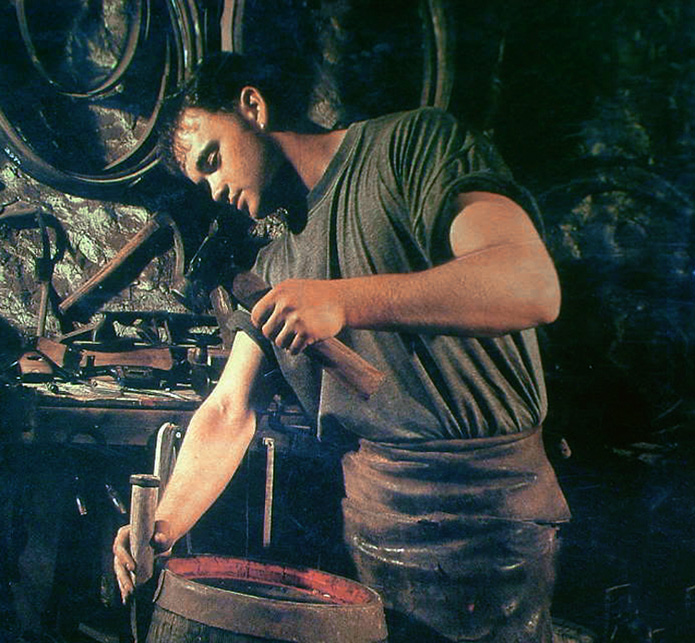
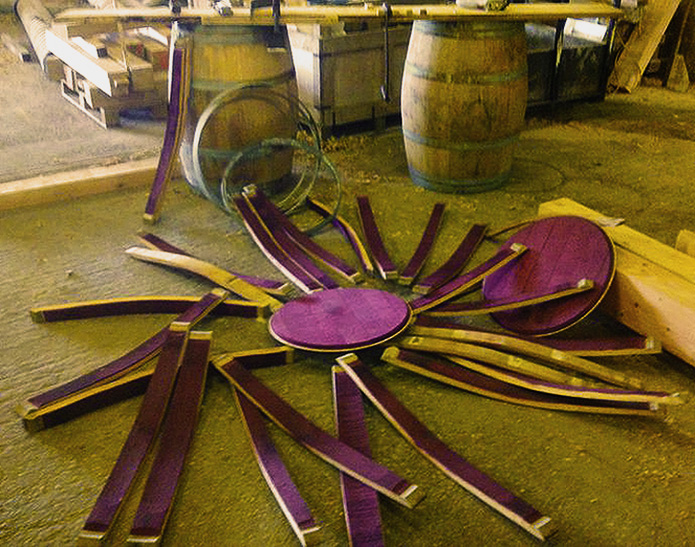
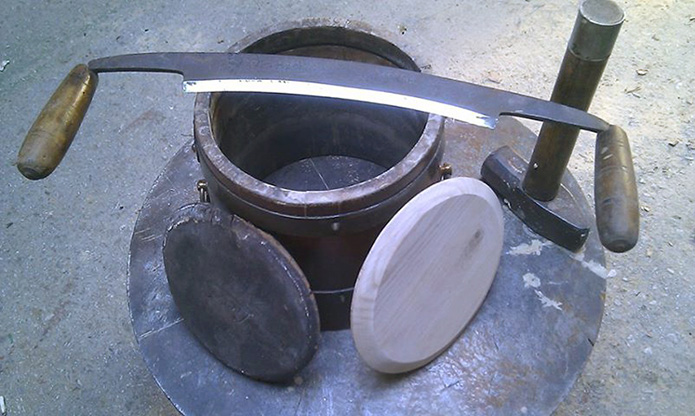
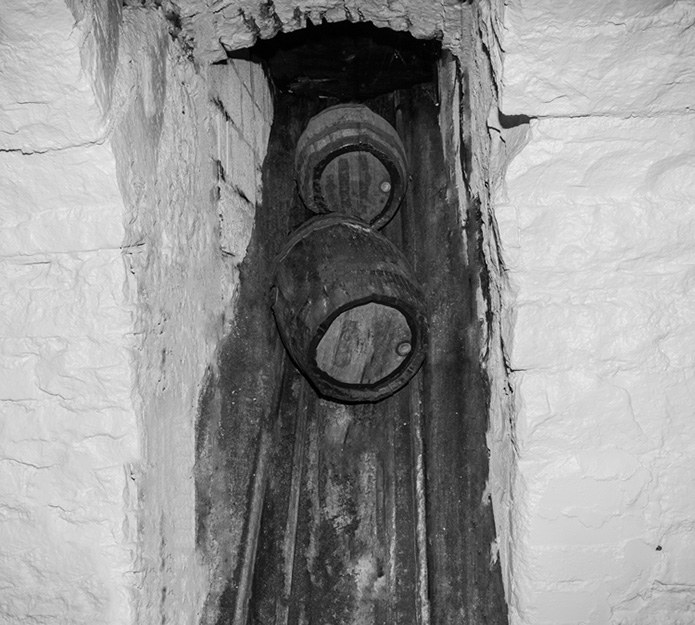
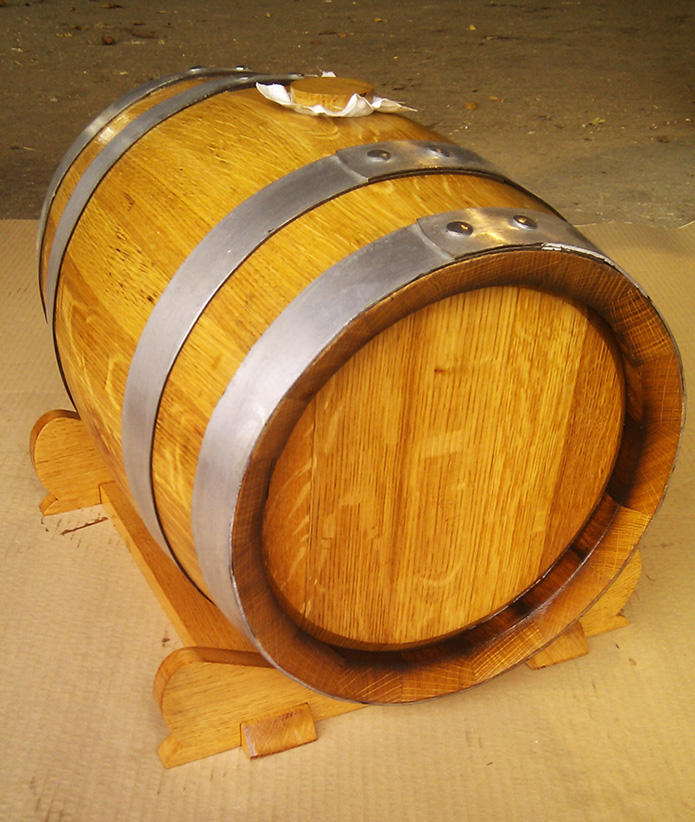
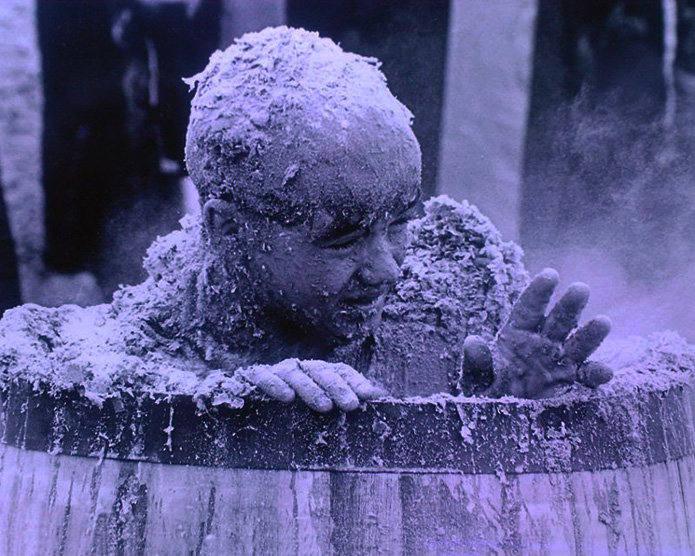
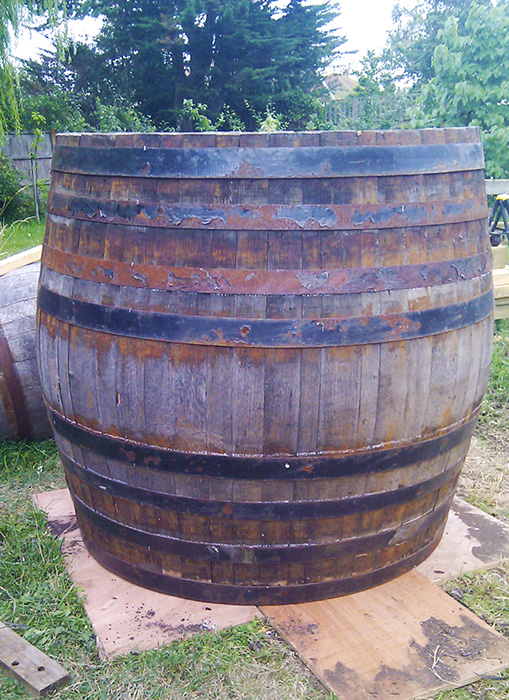
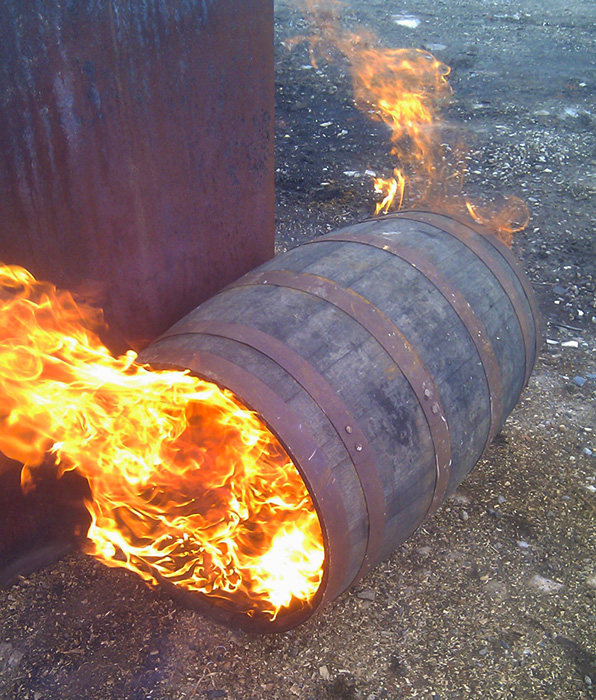
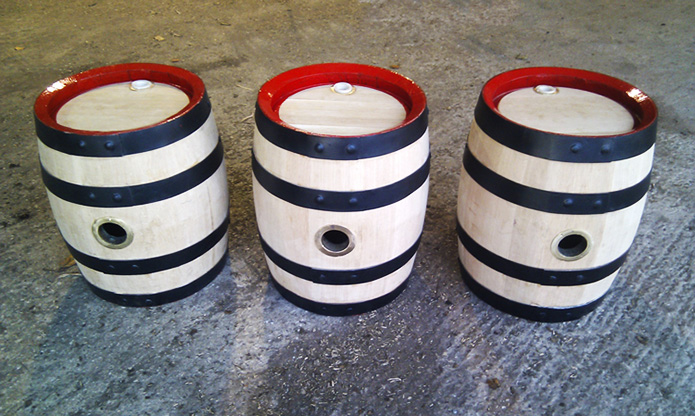
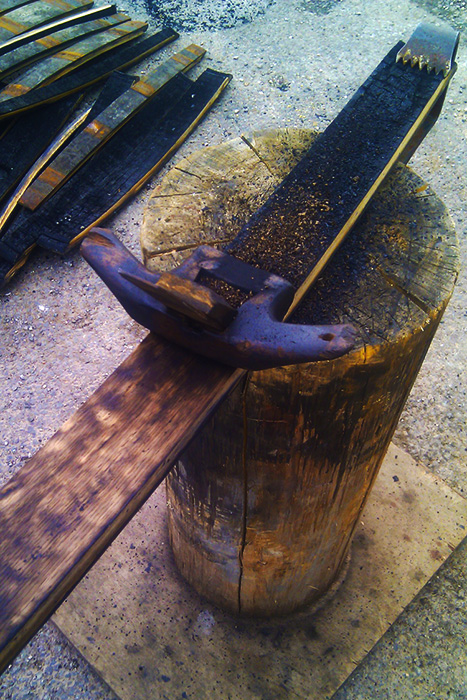
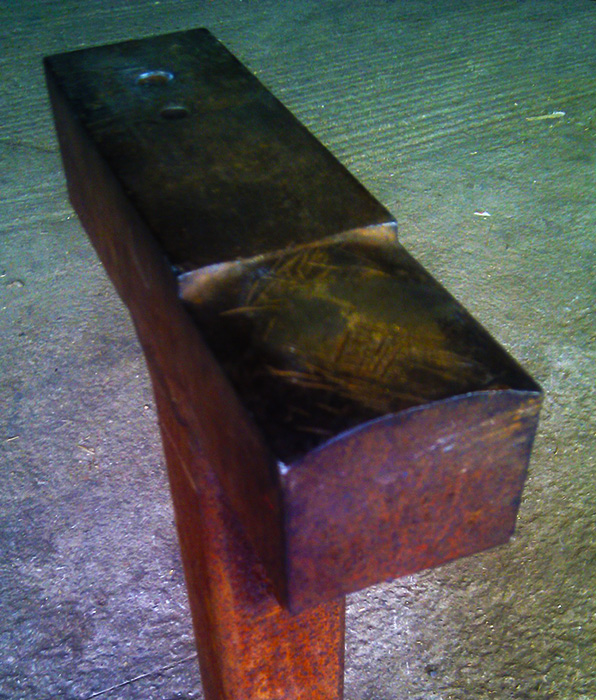
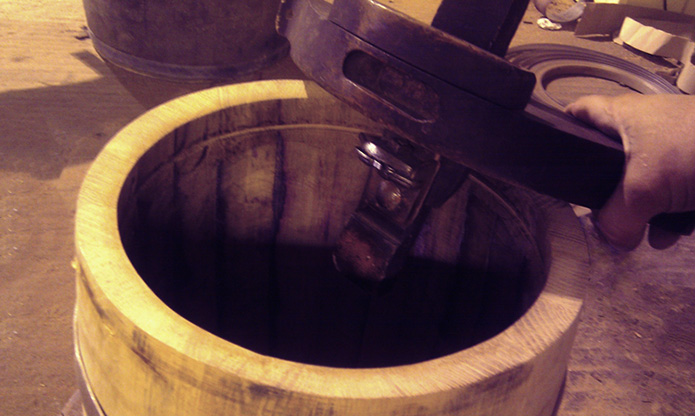
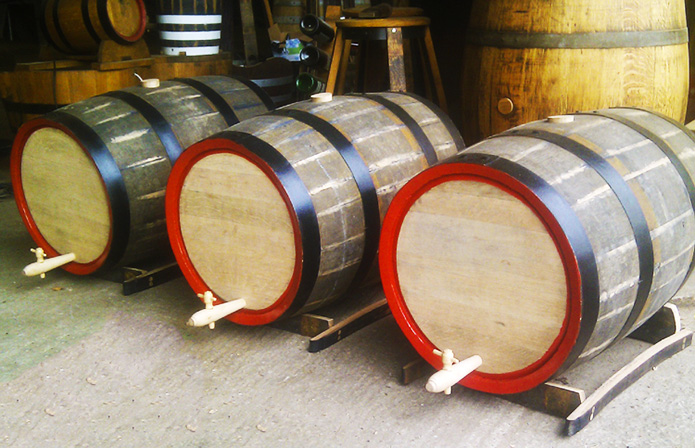
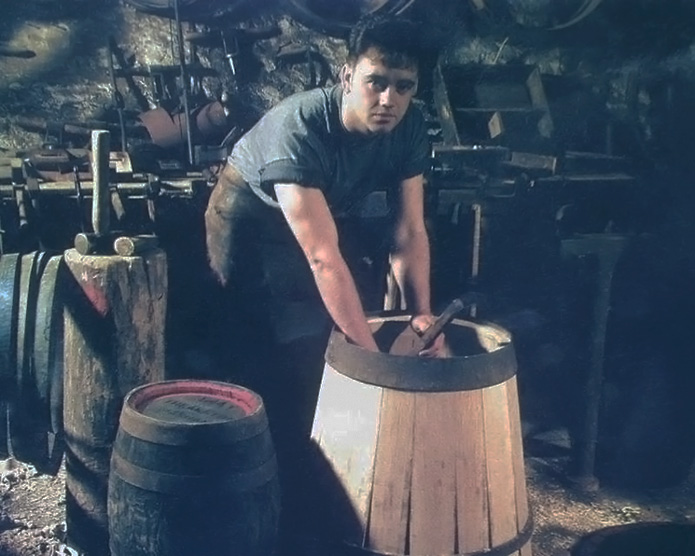
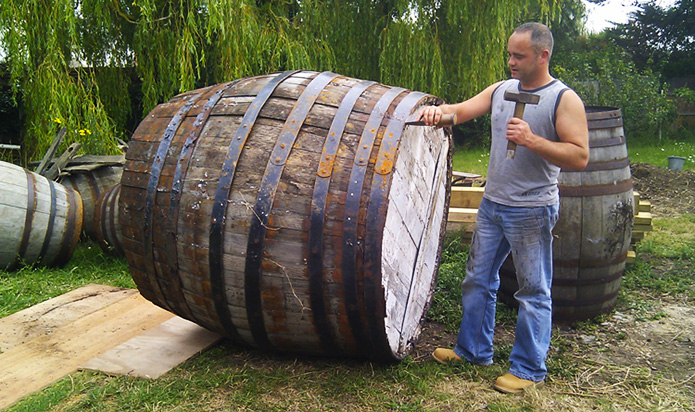
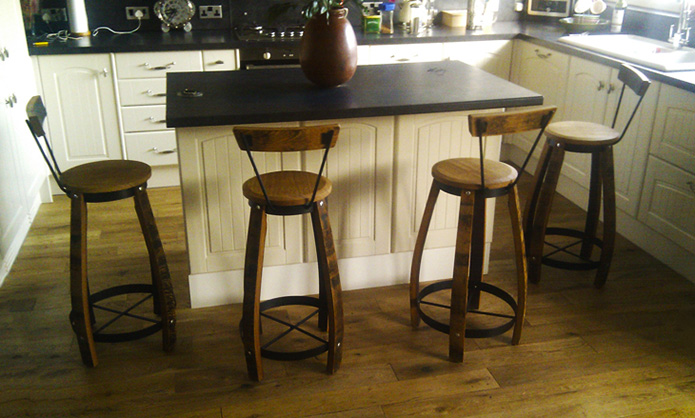
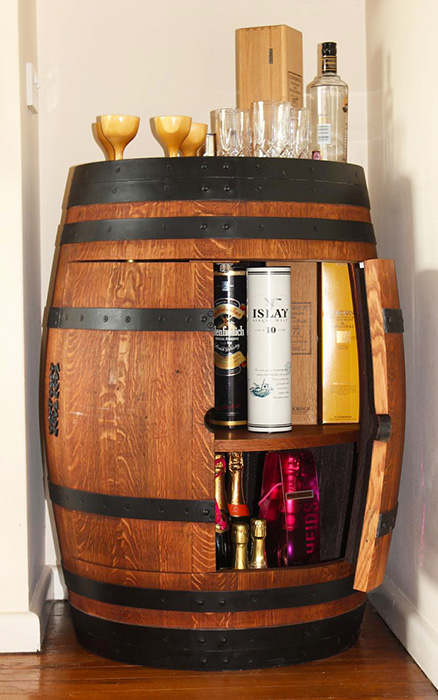
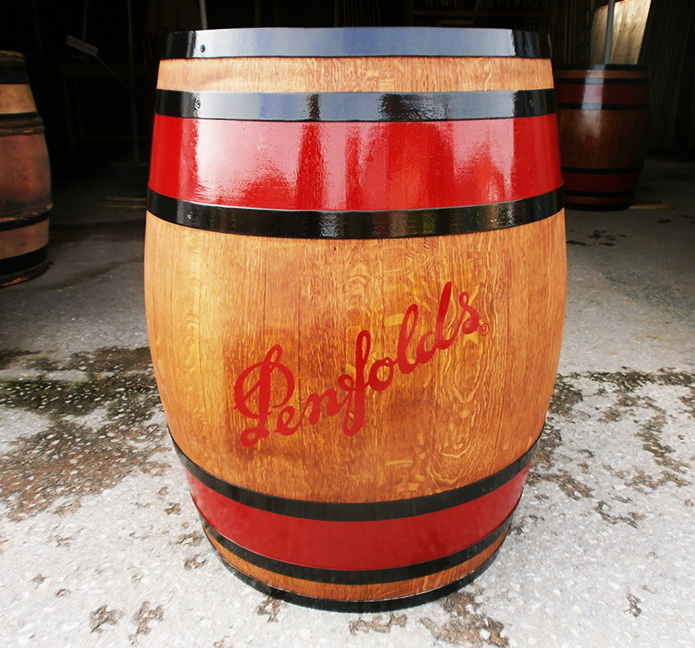
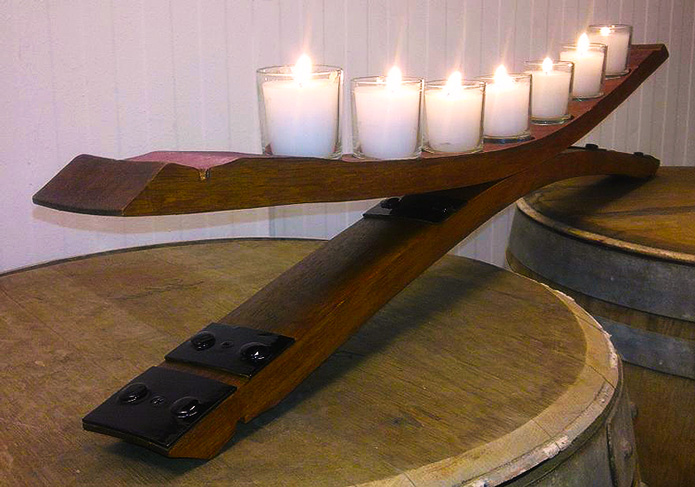
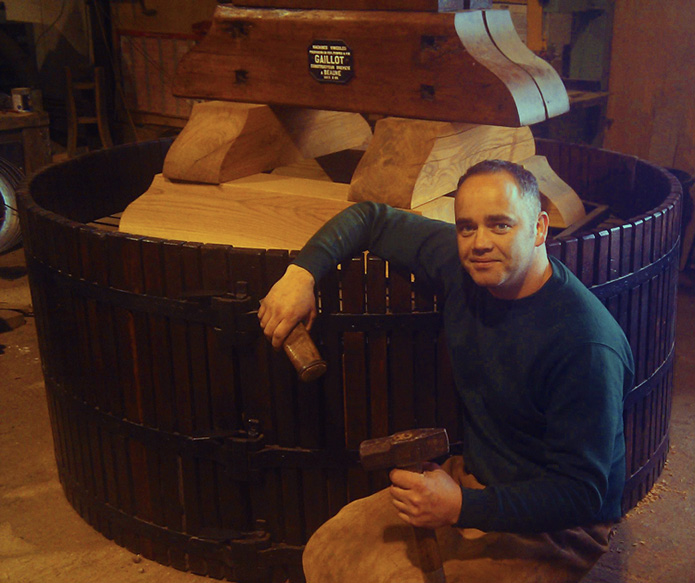
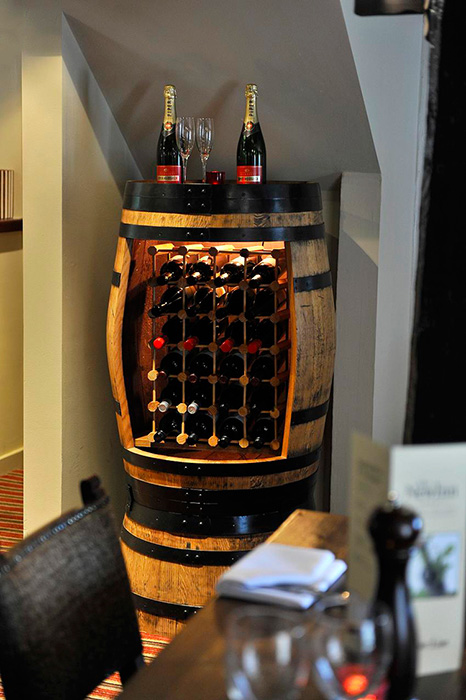
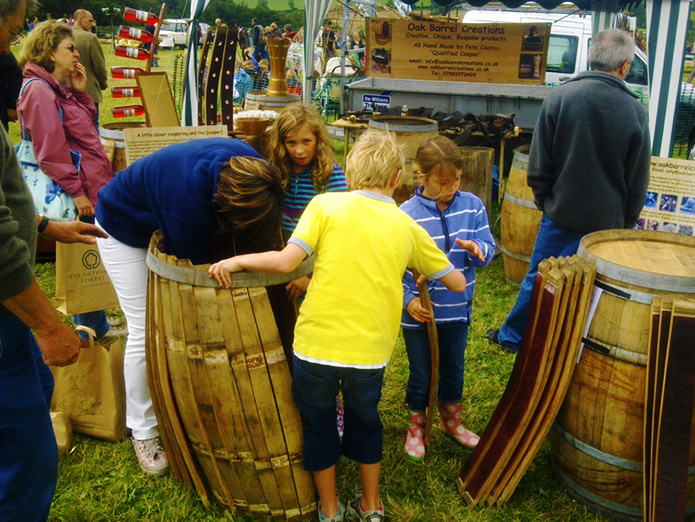
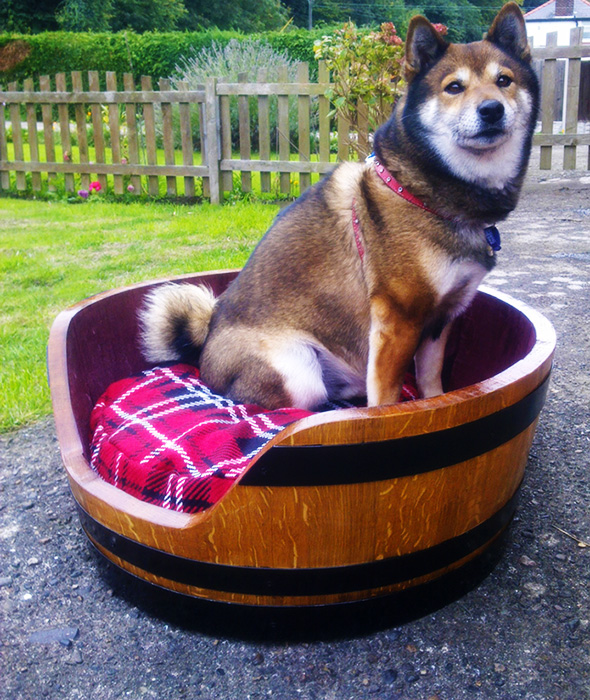









Monday, May 2nd 2016 at 10:10 am
[…] wooden hoops developed by northern European Celts during the Iron Age (a precursor to modern day ‘Coopering’; a traditional British craft). The Romans were sustained in Britain by a type of beer known as Celtic Ale, known as Ceruese […]
Friday, December 12th 2014 at 1:54 pm
Fascinating read. Well Done Peter!